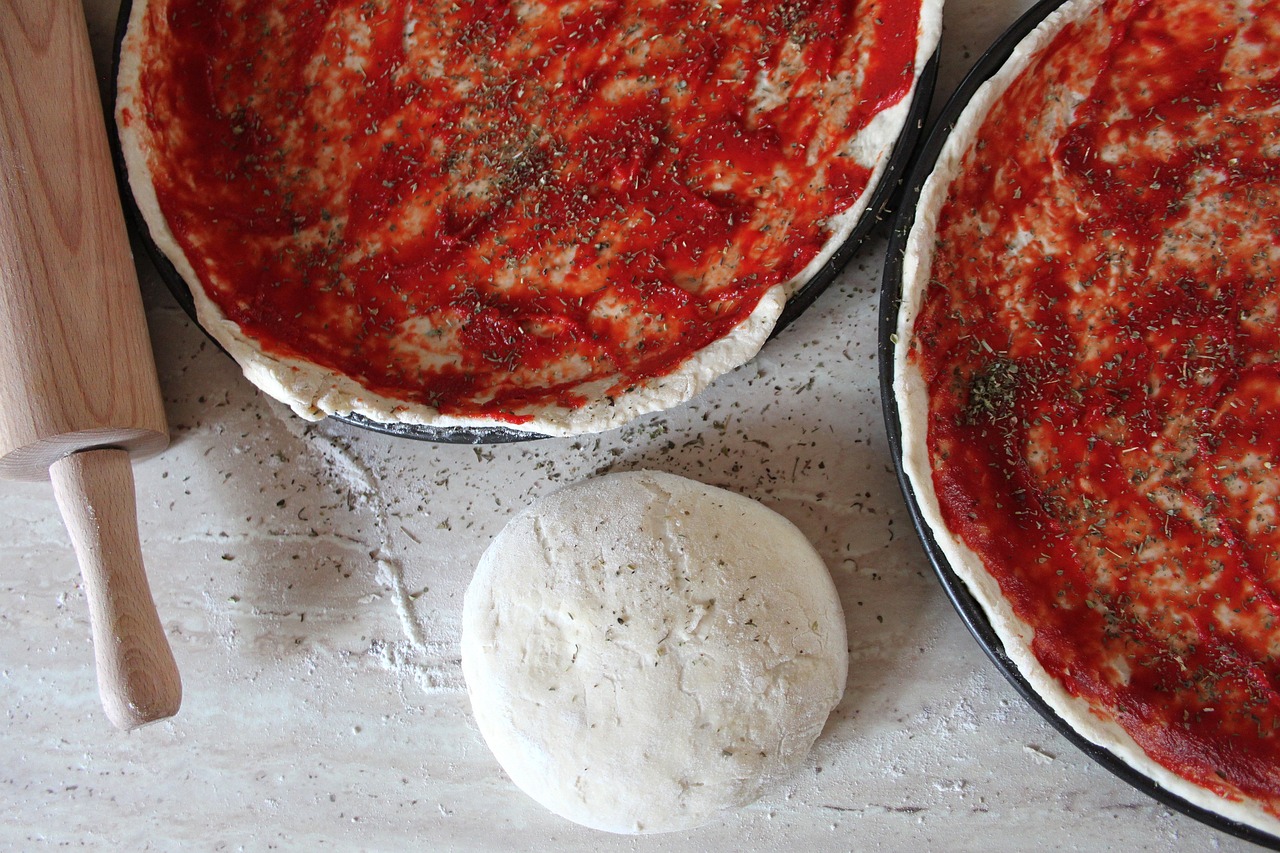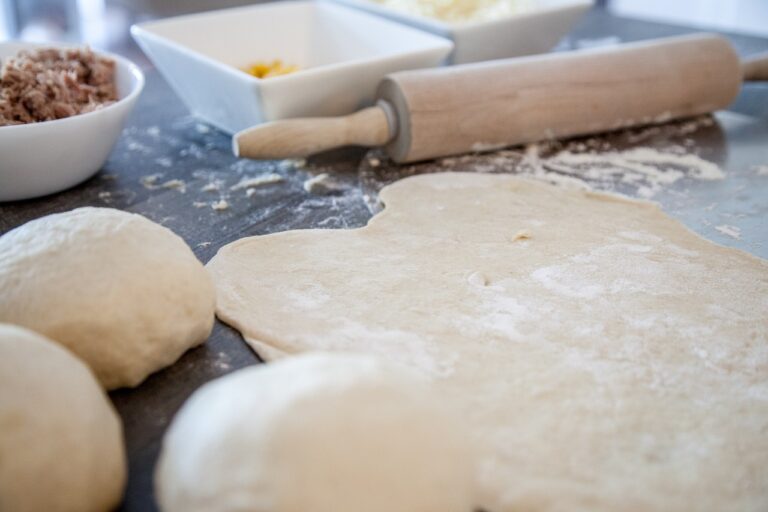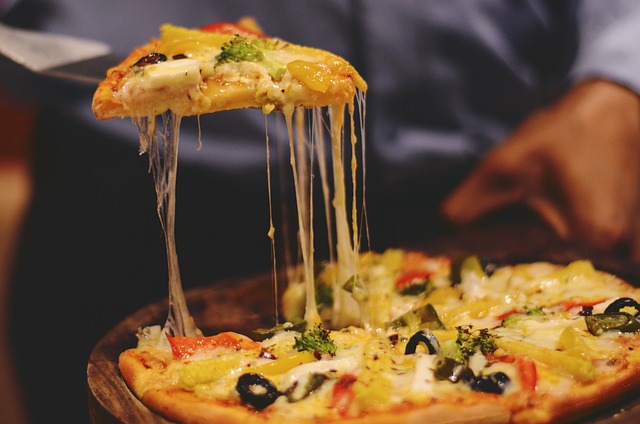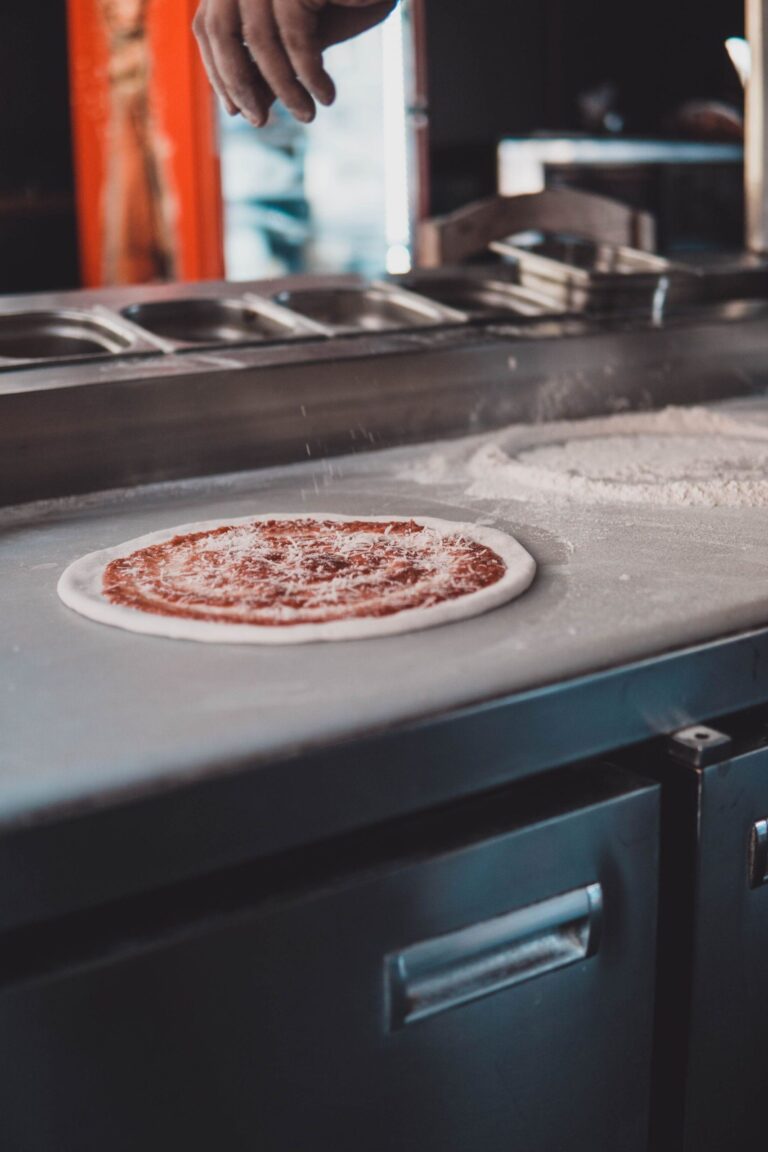Deep Dish Pizza Crust Recipe
Are you craving a thick, cheesy slice of deep-dish pizza? Look no further—we’ve got the perfect recipe for you.
In this article, we’ll show you how to make a mouthwatering, deep-dish pizza crust that will impress your taste buds. You’ll learn all the steps, from preparing the dough to baking and serving it with your favourite toppings. Get ready to indulge in a truly innovative and delicious pizza experience!
Ingredients for the Deep Dish Pizza Crust
For the deep dish pizza crust, you’ll need flour, cornmeal, yeast, water, olive oil, salt, and sugar. These ingredients combine to form a delicious and hearty base for your pizza creation. The flour provides structure and texture to the crust, while the cornmeal adds a subtle crunch and a touch of sweetness.
To make the crust, combine the yeast with warm water and let it sit for a few minutes until it becomes frothy. This is an essential step as it activates the yeast and helps the dough rise. Mix the flour, cornmeal, salt, and sugar separately. Then, add in the frothy yeast mixture along with some olive oil.
Now comes the fun part—kneading! Use your hands or a stand mixer with a dough hook attachment to knead the dough until it becomes smooth and elastic. This will take about 5-7 minutes.
Once your dough is ready, let it rise in a warm place for about an hour or until it has doubled. After that time has passed, punch the dough to release any air bubbles before shaping it into your desired deep-dish pizza crust.
Fear not if you’re looking for an alternative crust or gluten-free options! There are plenty of substitutions you can make. For gluten-free crusts, try using almond flour or a gluten-free all-purpose flour blend instead of regular flour. You can also experiment with cauliflower or zucchini-based crusts for added nutrition.
So go ahead and get creative with your deep-dish pizza crust! With these ingredients and inventive alternatives available to explore, you’ll be well on your way to creating innovative pizzas that satisfy all taste buds – whether they crave traditional flavours or seek dietary accommodations.
Preparing the Dough for the Deep Dish Pizza Crust
To prepare the dough, combine flour, yeast, salt, and water in a mixing bowl. Follow these steps for optimal results:
- Measure out the flour and pour it into the mixing bowl. Use a spoon to make a well in the center of the flour.
- Mix the yeast and warm water in a separate bowl until it dissolves. Let it sit for a few minutes until it becomes frothy.
- Pour the yeast mixture into the flour well. Add salt as well.
- Using your hands or a wooden spoon, gradually incorporate the dry ingredients into the wet ingredients until a sticky dough forms.
Now that you have prepared your basic pizza dough, why not add some herbs to elevate its flavour? Try adding dried oregano or basil for an Italian twist, or experiment with fresh rosemary or thyme for an aromatic touch.
Once you’ve added your desired herbs, knead them into the dough until evenly distributed. This will infuse each bite with delightful bursts of flavour.
Finally, cover your dough with plastic wrap and let it rise warmly for about an hour or until it has doubled. While waiting for your dough to rise, remember to preheat your oven to an optimal baking temperature of 450°F (232°C)!
Mixing and Kneading the Deep Dish Pizza Crust
You might wonder about the optimal kneading time and the best techniques when making a deep-dish pizza crust. Well, fear not—we’re here to guide you through it!
Discover how long you should be kneading your dough for that perfect texture, and learn some effective mixing techniques to ensure a deliciously crispy crust every time.
Optimal KneadinTimeme?
For optimal texture, you’ll want to knead the deep-dish pizza crust for about 10 minutes. Kneading is a crucial step in bread-making that helps develop gluten, giving the crust its desired chewy and airy consistency. However, it’s essential to understand the best kneading techniques and avoid common kneading mistakes.
To help you master the art of kneading, here are some tips:
| Technique | Description |
|---|---|
| Fold and Push | Use the heel of your hand to fold the dough in half towards you, then push it away using your body weight. Repeat this motion for about 10 minutes. |
| Stretch and Fold | Gently stretch a portion of dough upwards, then fold it back onto itself. Rotate the dough and repeat until well-kneaded. |
| Slap and Roll | Slap the dough against a clean surface, then roll it up tightly using both hands. |
Common mistakes include not kneading long enough or over-kneading, resulting in harsh or dense crusts. So remember to aim for that perfect balance when working on your deep-dish pizza crust!
Best Mixing Techniques?
Mixing the ingredients thoroughly is essential for achieving a smooth and well-incorporated dough.
When it comes to creating the perfect pizza, innovation is critical. You want to think beyond the traditional toppings and explore new flavours that excite your taste buds. While classics like pepperoni and mushrooms are always reliable, why not experiment with unique combinations? The possibilities are endless, from caramelized onions and goat cheese to prosciutto and arugula.
Don’t stop at just the toppings; consider alternative crust recipes as well. How about a cauliflower crust for a gluten-free option or a cornmeal crust for added texture? Mixing up your ingredients and trying different combinations will take your pizza game to new heights of deliciousness.
Get creative and enjoy exploring the world of innovative pizza-making!
Letting the Dough Rise for the Deep Dish Pizza Crust
When it comes to letting the dough rise for your deep-dish pizza crust, you might wonder about the optimal rising time and whether to use Timeeast or sourdough. It is finding the perfect balance between a light and airy crust and a flavorful one. We’ll explore different rising times and compare the effects of yeast versus sourdough on the taste and texture of your deep-dish pizza crust.
Optimal Rising Time?
For best results, let it rise until the dough has doubled in size. The optimal rising time for deep dish piTimecrust can vary depending on the temperature and type of yeast used. It is essential to provide ideal conditions for the dough to rise correctly. Yeast is a living organism that reacts to its environment, so maintaining an optimal temperature will encourage fermentation and create a light and airy crust. Different types of yeast, such as active dry yeast or instant yeast, may have other rising times. Here’s a table summarizing the optimal temperatures and rising times for common yeast types:
| Yeast Type | Optimal Temperature (Fahrenheit) | Rising Time (hours) |
|---|---|---|
| Active Dry | 110-115 | 1-2 |
| Instant | 95-100 | 0.5-1 |
| Fresh | 70 | Depends on recipe |
Yeast or Sourdough?
If you’re unsure whether to use yeast or sourdough for your dough, consider the flavour and texture each one provides.
Yeast is a reliable and fast-acting option that gives your crust a light and fluffy texture. It imparts a classic bread-like taste that complements the toppings well.
On the other hand, sourdough offers a unique tangy flavour profile with hints of acidity. Its longer fermentation process provides a more complex and chewy crust, adding depth to every bite. However, it requires patience and planning as it takes longer to rise than yeast.
Both options have pros and cons; it ultimately comes down to personal preference and the desired outcome of your deep-dish pizza crust. Experimentation with these two ingredients can lead to innovative culinary creations that will leave your taste buds wanting more.
Shaping and Preparing the Deep Dish Pizza Crust
Press the dough evenly into the greased pan to shape and prepare the deep-dish pizza crust. This step is crucial in achieving a crisp yet tender crust that holds all the delicious toppings together. But shaping techniques don’t end there—let’s explore some alternative crust options that can elevate your deep-dish pizza experience.
Innovation is vital when it comes to creating unique and exciting pizzas. Here are five alternative crust options that will take your deep-dish pizza game to the next level:
| Crust Option | Description | Emotion |
|---|---|---|
| Cauliflower | A low-carb option made from finely grated cauliflower, giving a light and crispy texture. | Surprise |
| Zucchini | Grated zucchini as a base creates a moist and flavorful crust with added vegetable goodness. | Refreshing |
| Sweet Potato | A naturally sweet and nutrient-rich choice, this crust adds depth of flavor to your pizza masterpiece. | Comforting |
| Polenta | Made from coarsely ground cornmeal, this corn-based crust offers a delightful crunch and rustic charm. | Rustic |
| Quinoa | Packed with protein and gluten-free, quinoa creates a hearty yet light crust for those looking for healthy alternatives. | Nourishing |
So go ahead and get creative with your deep-dish pizza! Experiment with different shaping techniques like these alternative crust options to surprise yourself and delight your taste buds with innovative flavours and textures.
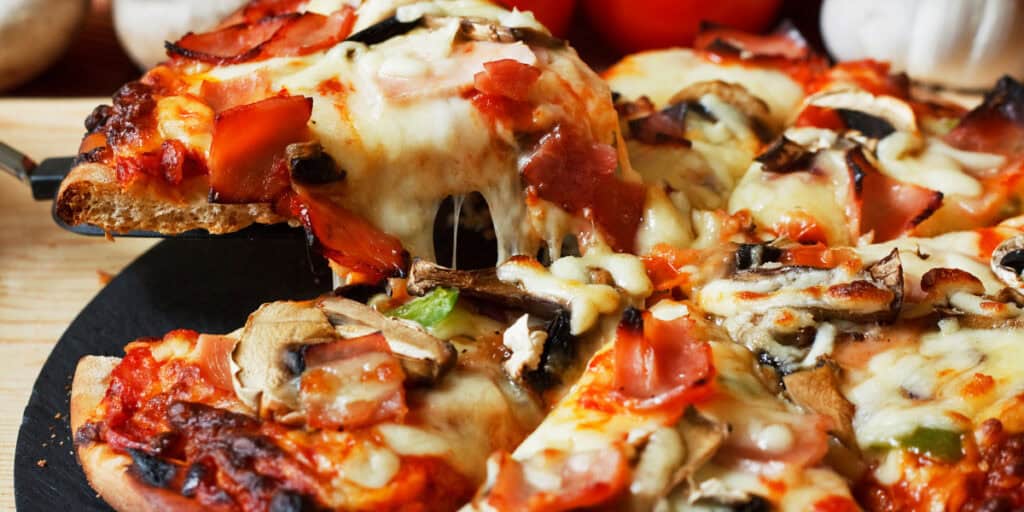
Par-baking the Deep Dish Pizza Crust
Par-baking the crust ensures that it is partially cooked before adding the toppings. This technique is essential for achieving a crispy, deep-dish pizza crust. Here are some par-baking methods that will take your pizza to the next level:
-
Preheat your oven to a high temperature, around 450°F (230°C). This will help create a crispier crust.
Roll out your dough and place it in a greased, deep-dish pizza pan. Press the dough up against the sides of the pan to create that iconic deep-dish shape.
-
Prick the surface of the dough with a fork to prevent air bubbles from forming during baking.
-
Bake the dough in the oven for about 10 minutes or until it turns golden brown.
-
Remove the partially baked crust from the oven and let it cool slightly before adding your desired toppings.
By par-baking your deep-dish pizza crust, you allow it to develop a sturdy base while still maintaining its softness on top. This balance creates an irresistible texture that is both chewy and crispy.
So try these par-baking techniques for an innovative twist on traditional deep-dish pizza!
Adding the Toppings to the Deep Dish Pizza Crust
When adding the toppings, layer them evenly on top of the partially baked crust. This is where you can get creative and experiment with different topping combinations to create a genuinely unique deep-dish pizza. The possibilities are endless, from classic pepperoni and cheese to gourmet combinations like prosciutto and arugula.
To achieve the perfect balance of flavours, it’s essential to consider the textures and tastes of your chosen toppings. For example, if you’re using vegetables like bell peppers or onions, sautéing them beforehand will enhance their flavour and prevent them from becoming soggy during baking.
If you’re looking for alternative crust options, why not try a cauliflower crust? It’s a healthier option that provides a delicious base for your toppings. Grate cauliflower into fine crumbs, steam until tender, squeeze out excess moisture, mix with eggs and cheese, then press into your pan before par-baking.
Another innovative idea is using polenta as a crust alternative. Prepare polenta according to package instructions, spread it onto your greased pan while hot, let it cool, and firm up slightly before adding your toppings.
Remember that the key to deep-dish pizza is customization. Don’t be afraid to think outside the box and create your signature pizza masterpiece!
Baking and Serving the Deep Dish Pizza Crust
Once the toppings are added, it’s time to bake the crusTimed serve your delicious deep-dish pizza. To achieve that perfect crispy yet soft texture, preheat your oven to 425°F (218°C). This high temperature will ensure that the crust bakes evenly and becomes golden brown.
While the oven is heating up, let’s take a moment to appreciate the importance of a well-balanced cheese blend for your deep-dish pizza. The combination of different cheeses adds depth of flavour and enhances the overall taste of your creation. Here’s a table showcasing some popular cheese blends for deep-dish pizzas:
| Cheese Blend | Description |
|---|---|
| Mozzarella | Classic, mild, and stretchy |
| Cheddar | Sharp and tangy |
| Parmesan | Nutty and slightly salty |
| Provolone | Creamy with a hint of smokiness |
| Fontina | Buttery and melts beautifully |
Feel free to experiment with different ratios or add other cheese types to create your signature blend!
Once you have assembled your deep-dish pizza with all the desired toppings, please place it in the oven. Bake for approximately 20-25 minutes or until the crust is golden brown and the cheese is bubbly and melty. Remove from the oven carefully using oven mitts, as it will be hot.
Allow it to cool for a few minutes before slicing into wedges and serving. The aroma alone will entice everyone around you! Enjoy this innovative twist on traditional pizza-making!
